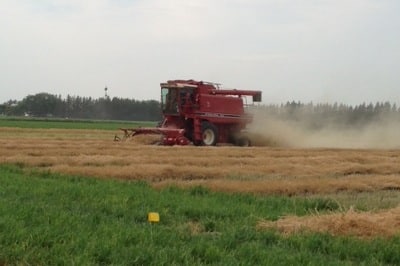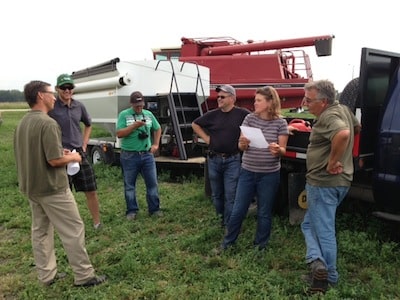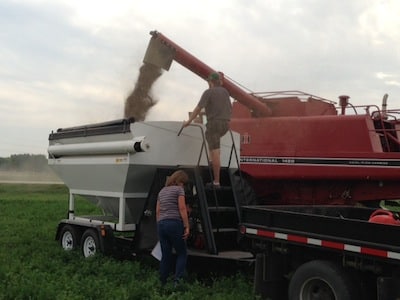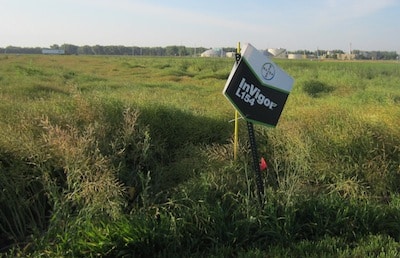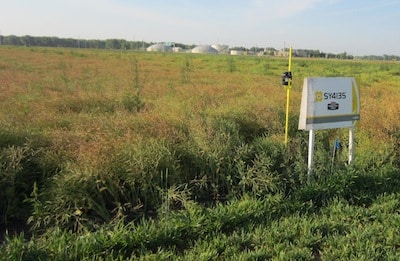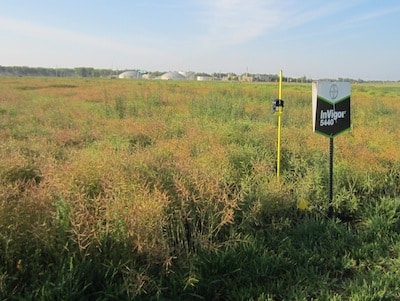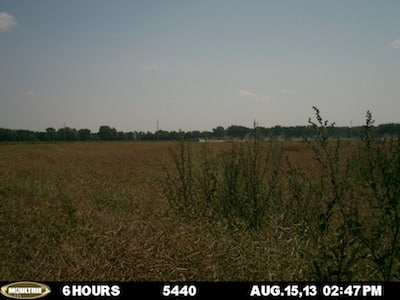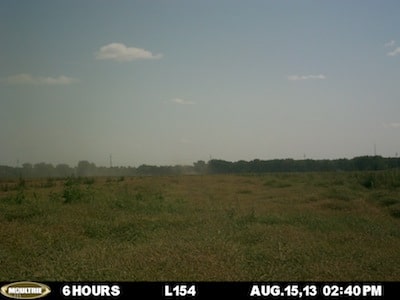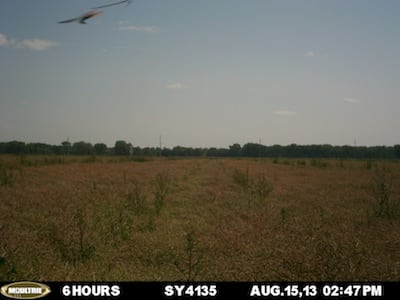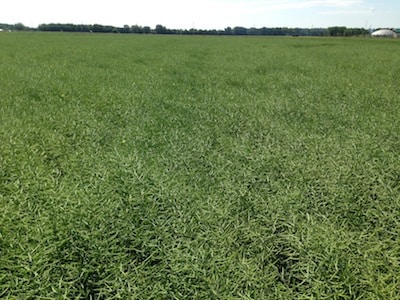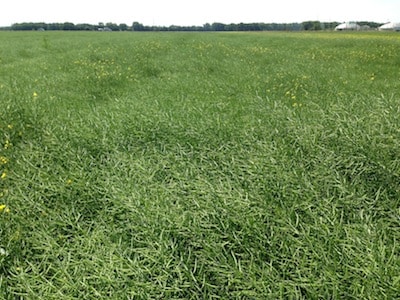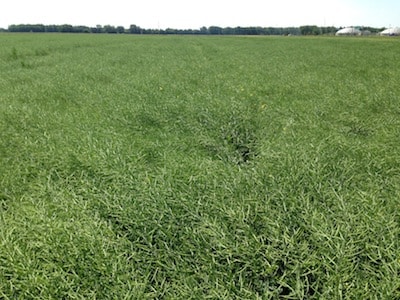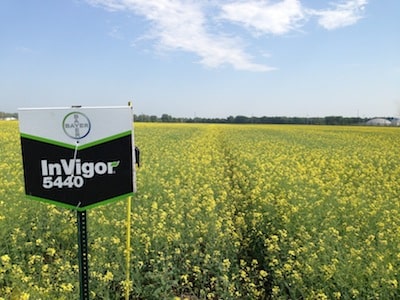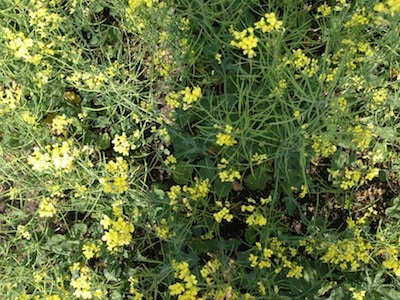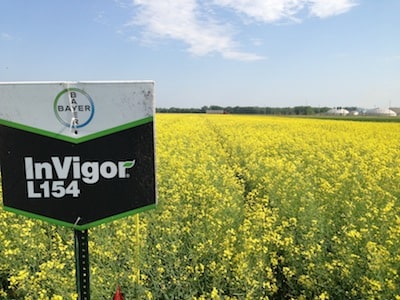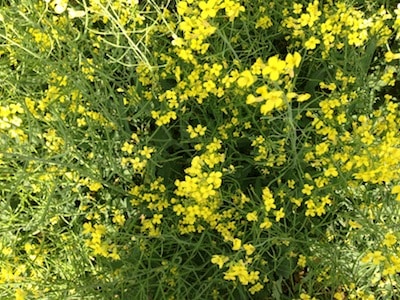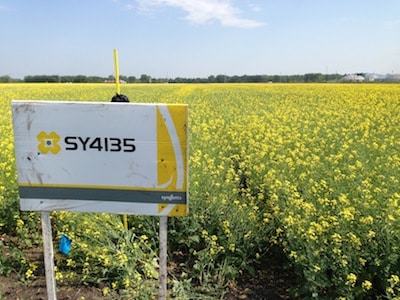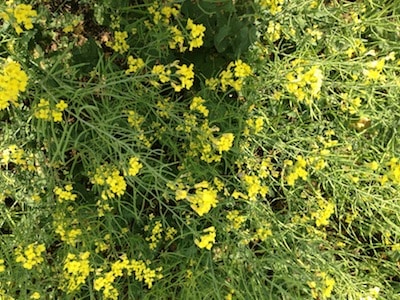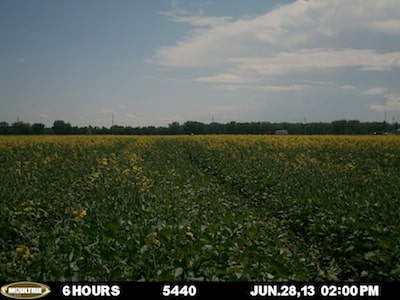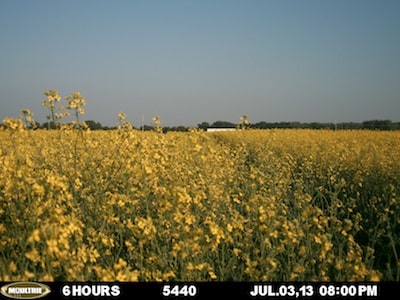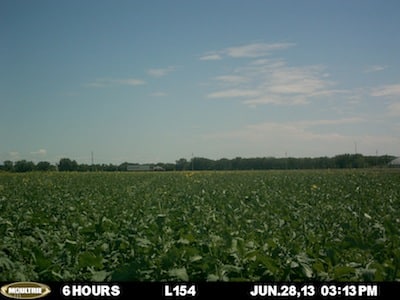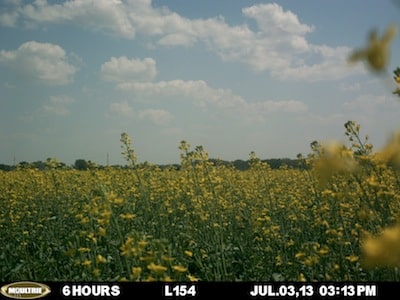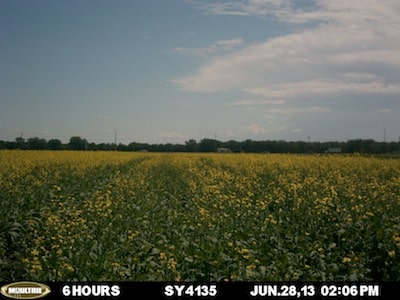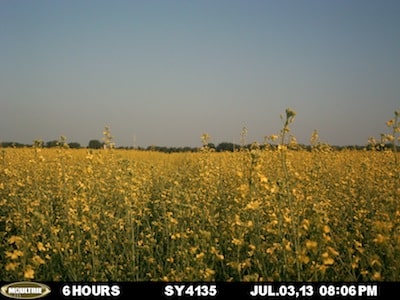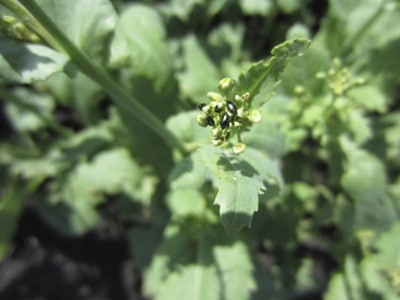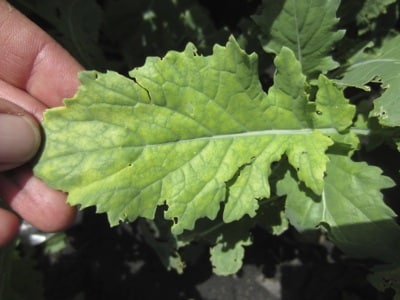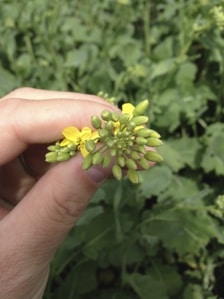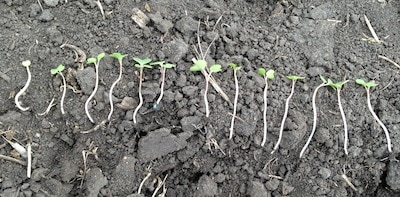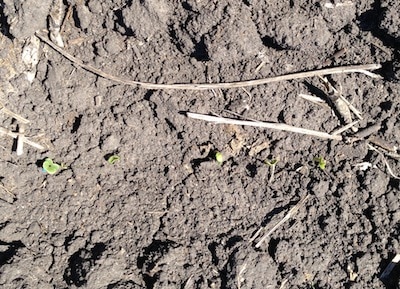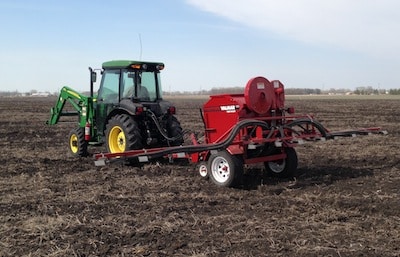Final results
August 28 update
August 22 update
August 16 update
August 15 update
July 30 tour
July 19 update
July 11 update
July 5 update
July 2 update
June 28 update
June 27 update
June 13 update
June 11 update
Blackleg Scouting Clinic at UCC: June 7
June 6 update
May 30 update
May 28 update
May 27 update
May 24 update
May 23 update
May 16 update
May 15 update
Weather reports
CCC agronomy specialists have a new project for 2013 — the Ultimate Canola Challenge (UCC). The underlying challenge is to follow all best management practices (BMPs) to see how canola yields when you “do everything right.”
Manitoba has a slightly different take on the UCC, with three teams testing their own combination of inputs and practices to see which can achieve the top canola result. The ultimate winner will be which system made the most profit. Best management practices will be essential if the team wants to win. Teams will compete side by side at the Canada Manitoba Crop Diversification Centre (CMCDC) at Portage la Prairie.
The teams:
Team CROP is led by the local grower group.
Team MAFRI is led by our provincial oilseed specialist Anastasia Kubinec.
Team CCA is the certified crops agronomists team led by Curtis Cavers of AAFC.
Final results
First place: Team CROP (L154), Team leader Shawn Cabak: Spent $426.59/ac to get their crop and at $11.50/bu selling price their ROI was $286.75 and the break even yield they needed was 37.10 bu/ac
Team MAFRI (SY4135), Team leader Anastasia Kubinec: Spent $410.57/ac to get their crop and at $11.50/bu selling price their ROI was $285.99 and the break even yield they needed was 35.70 bu/ac
Team CCA (5440), Team leader Curtis Cavers: Spent $452.73/ac to get their crop and at $11.50/bu selling price their ROI was $249.23 and the break even yield they needed was 39.37 bu/ac
Based on economics, Team CROP won by $0.76/ac!
Team CROP’s rationale for their decisions through the season:
Variety choice: L154. Liberty Link canola has done well locally. L154 has been high yielding in the MCVET trials and local growers have grown it successfully.
Seeding rate: 5 lb./ac. might be a higher seeding rate than what is normally used with current varieties and equipment, but was justified with a press drill.
Seeding speed: 5 mph. Since rain was in the forecast we wanted to get the seed in the ground quickly
Herbicide rate: 1.35 l/acre Liberty. Presence of harder to control weeds (dandelion & vol alfalfa) required a higher rate of Liberty for optimal control.
Fungicide: Proline at 147 ml/acre at 20% flowering. Local growers and retailers have had good experience with Proline. A higher rate was used as weather conditions were favourable for sclerotinia development.
Insecticide: Matador at 34 ml/acre. High flea beetle pressure and a high yield potential warranted the insecticide applications.
Time of swathing: 60-70% seed color change. Hot and dry conditions rapidly advanced the crop maturity over the weekend. The crop was swathed early in the morning when there was a dew to prevent shattering.
TEAM CCA’s rationale for their choices throughout the growing season:
Variety Selection: Invigor 5440. Why: Proven variety; available seed; cheaper??? Prefer Liberty Link varieties for herbicide rotation in overall crop rotation plans.
Seeder Selection: Valmar. Why: Running out of time to seed before rain; wanted different seeding method than other two teams
Fertility: 120-25-0-15 Why: As per AgVise soil test recommendation and consultation with colleagues.
Fertility Application Method: Broadcast and incorporated. Why: Available equipment on site for rapid application and seedbed preparation
Seeding Date: May 16, 2013. Why: As early as conditions allowed
Seeding Rate: 7.2 lb/ac. Why: This was the closest Valmar setting to the 7 lb/ac target. Wanted a heavier stand than other two teams.
Seeding Depth: Surface with incorporation by tine harrows. Broadcast seeding and incorporation method.
Seeding Speed: Approx 4 mph. Why: Using small scale equipment – relatively slow to manage bumps and watch application closely
Pre-seed burnoff: No. Why: Clean field
Pre-emergent burnoff: No. Why: Clean field
Weed control: Liberty + Headline @ 1.35 L/ac and 160 mL/ac on June 13. Why: Liberty applied at high rate to control hard-to-kill weeds (dandelion, Canada thistle, some patches of quackgrass). Liberty more expensive than glyphosate but wanted Liberty in crop rotation as part of herbicide rotation; Headline applied to control Blackleg and Black spot as a plant health measure due to thick stand.
Insecticides: Matador @ 33.2 mL/ac on June 11 and June 28. Why: Flea beetle control for all canola plots in UCC trial according to Guide to Field Crop Protection 2013.
Sclerontinia Fungicide: Yes, Astound @ 35% bloom @ 395 g/ac on July 2. Why: Heavy application rate at later end of window to protect thick stand and avoid additional applications. Weather conditions/forecast believed to be conducive to onset of sclerotinia/
Harvest method: Swathed @ 40-80% seed color change on Aug 16. Why: Was thinking about straight cutting but advised not to because seed colour change highly variable due to broadcast seeding. Some shattering when swathing commenced.
Combined: Aug 26. Third team to be harvested on the same day as the other two teams. 8.6% moisture.
TEAM MAFRI’s Rationale
Variety: SY4135 – variety was chosen based on the 2 year WCC/RRC data for 2010-2011. It had the highest positive mix of characteristics suitable for the Portage la Prairie growing area from all the varieties being tested in the 2013 CPT program in the Long Season Canola Growing Zone. The attributes looked for were yield consistency (similar or superior to 5440/45H29) through all zones, but Mid and Long for MB markets, good Blackleg tolerance vs. Westar (20.9% or lower), maturity/height earlier than 5440, and better lodging. It got bonus points for the higher oil content (which could mean a premium to a farmer), and we wanted an RR tolerant variety because Roundup is one chemical not frequently in the fields rotation provided by CMCDC Field sheets. As well it looked like no other RR crops planned for the field and there were dandelion and Canada thistle seedling or carcasses in the field so Roundup would be a good rotational herbicide to clean up some potential issues in the 2013 growing season.
Seeding Rate: Based on the TKW of 5.11g I used a 5.5 lbs/ac seeding rate to hopefully get the 8-14 plants/ft2 established. The weather up to the seeding date had been cool and damp, so we were concerned that the establishment rate would be only 50% seed survival, so using a 5 lb/ac or 4.5 lb/ac seeding rate would have left us with a pretty this stand.
Seeding speed: We chose a slower speed to get more uniform placements of seeds in the seedbed. Again with the poor looking spring we were trying to get an even and hopefully thicker stand to get the 8-14 plants/ft2 established.
Herbicide Rate: Used the recommended rate in the Guide to Crop Protection based on the weed species and densities present in the plot
Fungicide for Blackleg: We did not apply a fungicide as canola had not been in the rotation for the past 4 years and we could not see any canola stubble evidence in the field. As well we were using an R rated variety that we knew had good tolerance to blackleg
Insecticide for flea beetles: Sprayed twice due to the populations of flea beetles and stage of the crop (only 3-4 leaves and seed had been in ground for almost a month with 25% defoliation). Sprayed again at early flower because the flea beetles were eating the buds.
Sclerotinia fungicide: at 20% flower and went with lower rate of Astound as the pressure was there (dry beans in 2012 with stubble around and potential sclerots, good canopy). But the weather was hot and dry so it was assessed that pressure was not high.
Swathing timing: Scouted and assessed the field for 3 days up to swathing waiting and gauging for 60 – 70% seed color change
TEAM CROP’s rationale
To come
August 28 update
The site was combined August 26. Initial yield numbers are L154 at 60.77 bu./ac.; 5440 at 60.20 bu./ac.; and SY4135 at 59.51 bu./ac. Statistically, these yields are identical. Adjustments will be made for moisture, green seed and dockage, and then each team will be evaluated based on final economics before declaring the winner. Here are some harvest day photos:

August 22 update
Anastasia Kubinec’s assessment of swaths…
5440: Top 3/4 of swath has dried down, bottom 1/4 is still somewhat green, but entire swath will be dried down probably by the end of the day of Friday, Aug. 23.
SY4135: Top 2/3 of swath has dried down, bottom 1/3 is somewhat green. Entire swath will be dried down sometime on Saturday, Aug. 24.
L154: Top 1/3 of swath has dried down, bottom 2/3 is very green to somewhat green, entire swath will be dried down sometime on Monday, Aug. 26.
Based on the weather forecast for the weekend (hot, maybe a small shower but not windy) and coordination and availability of equipment and personnel at CMCDC, the plan is to harvest starting Monday (Aug 26) morning.
August 16 update
Here are the plots as they looked August 16, just before swathing.
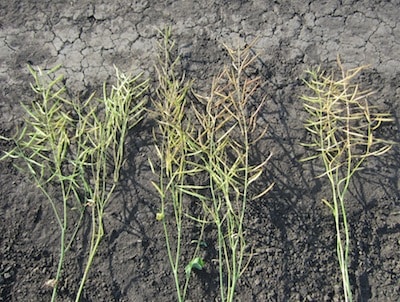
Anastasia Kubinec’s assessment on Friday morning of seed colour change and branching on the plants…
L154: 30-40% SCC, plant had shorter raceme with one main branch and one side branch. To be swathed on Monday Aug. 19.
SY4135: 50-70% SCC, plant had a longer raceme with one main branch and 2 (or more) side branches. Swathing on Aug. 16, after 5440, no concerns on shelling.
5440: 50-80% SCC, plant had a longer raceme with one main branch and 2 (or more) side branches. Swathing starting at 8:30am on Friday Aug. 16 as some concerns of shelling.
August 15 update
July 30 tour
July 19 update
Here is the latest spreadsheet will the decisions made so far: UCC 2013 Decisions
All plots are finished flowering and are in full pod-fill mode. Everything is looking good, and it’s hard to see any clear leader.
July 11 update
The signs are out. Here are side and overhead views for each of the three plots.
July 5 update
Here are two more time lapse photos for each plot, showing how quickly plots advanced from June 28 to July 3.
July 2 update
5440 received Astound at 395 grams/acre in 113 L of water/acre as it was at 35% bloom. The temperature was 23°C and there was a 5.5 km/hour wind. Applied with the Brown Nozzle Yellow Cap
at 40 psi.
L154 received Proline @ 147 ml/acre in 67.3 L of water/acre as it was at 20% bloom (Agral 90 was used as the surfactant.) The temperature was 24.6°C and there was a 6.9 km/hour wind. Applied with the Blue Nozzle at 40 psi.
June 28 update
We have flea beetles still! And feeding is occurring on the buds. A blanket application of insecticide (this will be the second) went on the entire trial to kill flea beetles off and reduce the bud damage. All plots and the guards received Matador @ 34 ml/acre. The temperature was 18.1°C and there was a 6.7 km/hour wind.
SY4135 received Astound @ 314 grams/acre in 113 L of water/acre as it was at 20% bloom. The temperature was 21°C and there was a 10.6 km/hour wind. We used Brown Nozzle Yellow Cap
at 40 psi.
June 27 update
As you can see we have what looks to be sulphur deficiency showing up, but I have sent samples to the Diagnostic Lab to be confirmed. I am wondering if this is a result of the cool conditions and slow growth and now the very fast growth and advancement, I think the canola hasn’t developed the root system yet to mine the sulphur that was put down…..I am hoping this will be alleviated soon as canola can increase its root system very quickly when it needs to.
The ground is wet, but the canopy for the most part is dry and not completely closed in SY4135 and L154, the 5440 plant stand is very thick and closed, but canopy was still not wet.
Flowering Notes Taken:
SY4135 = 8 to 18 flowers opened/pods, average was 15
5440 = 0 to 8 flowers opened/pods, average was 5
L154 = 0 to 5 flowers opened, average was 1.
June 13 update
Plots were sprayed for weeds. Weeds present were redroot pigweed (light to moderate infestation),
lamb’s quarters (light to moderate infestation), and dandelion rosettes (light to moderate infestation, mostly just patches).
SY4135 received Roundup Weathermax at 0.34 L/acre. Temperature was 21°C and there was a 5 km/hour wind
L154 received Liberty 150 SN @ 1.35 L/acre. Temperature was 22°C and there was a 4.1 km/hour wind.
5440 received Liberty 150 SN @ 1.35 L/acre and Headline EC @ 160 ml/acre. Temperature was 21°C and there was a 4.3 km/hour wind.
June 11 update
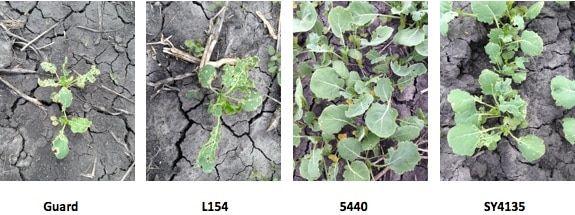
Plots were sprayed for flea beetles. Defoliation was at 25-30%, the action threshold. All plots and the guards received Matador @ 34 ml/acre in 67 litres of water per acre. Sprayed at 5 mph, using Tee-Jet Low Pressure Air-induced nozzles at 40 psi.
We have a time lapse camera set up at each of the 3 trials, taking 3 photos per day. We will make a video to cycle through all photos quickly. In the mean time, here are a few for each variety.
Team CROP — L154
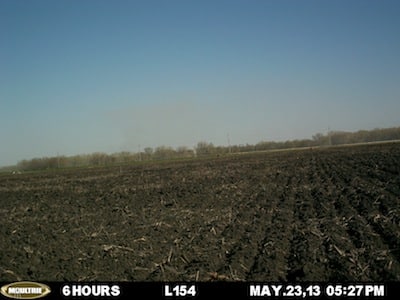
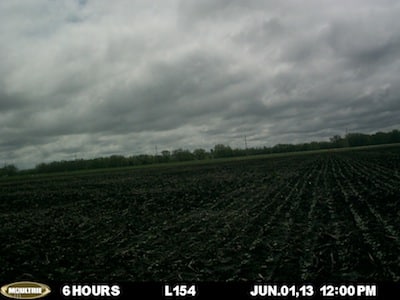
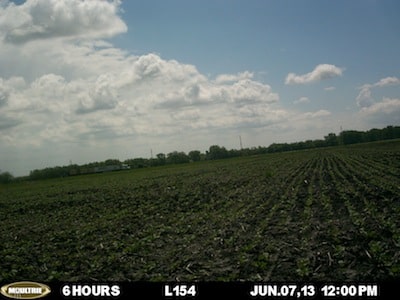
Team CCA — 5440
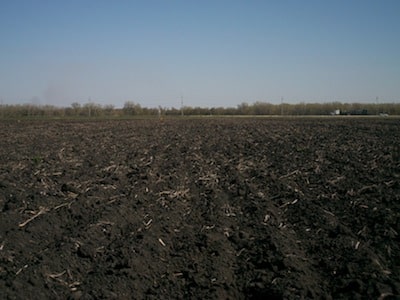
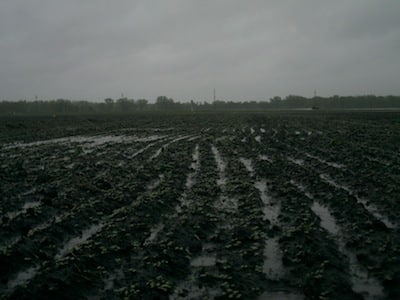
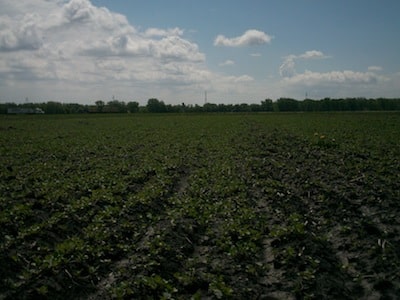
Team MAFRI — SY4135
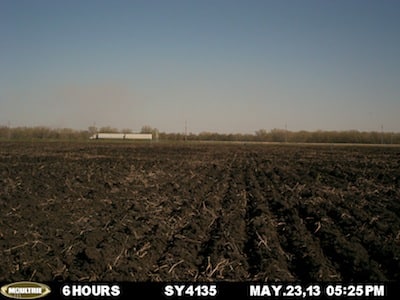
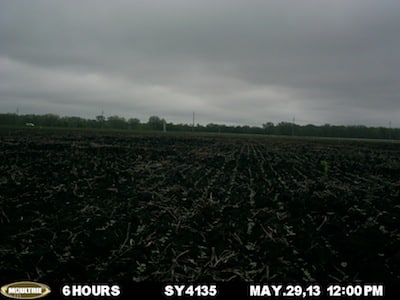
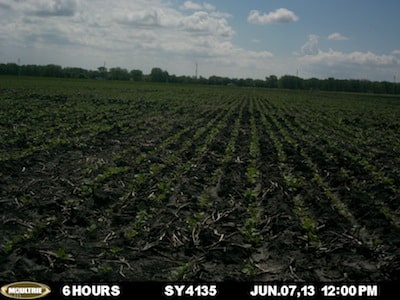
Blackleg Scouting Clinic at UCC: June 7
Producers and agronomists, come to the UCC Manitoba site June 7 at 10 a.m. for an Early Blackleg Scouting Clinic. The Canola Council of Canada, Manitoba Canola Growers Association, Manitoba Agriculture Food and Rural Initiatives and Canada Manitoba Crop Diversification Centres are your hosts.
Please show up a little early so we can transport you out to the (#UCC) Ultimate Canola Challenge Site!
You will learn:
How to scout for Blackleg?
What Blackleg looks like on the stubble?
What Blackleg looks like on a young canola plant?
What research is currently being done on Blackleg and how this will impact our futures!
For more information, call Kristen at 204-720-6923.
CMCDC is located at 370 River Road Portage la Prairie, MB
June 6 update
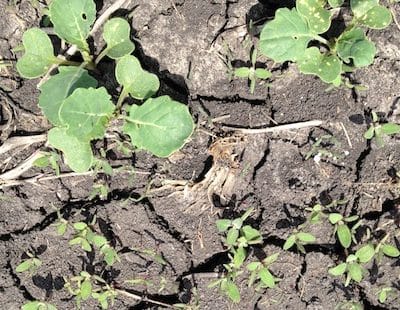
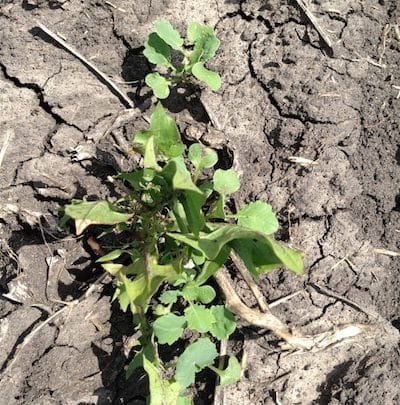
The crop looks great. It is nicely in the two leaf stage. Some flea beetle feeding has occurred but is likely only at the 5% defoliation at this point.
As far as weeds go, the field is actually fairly clean, with a little bit of redroot pigweed and some lamb’s quarters. A few patches have 4″ to 6″ dandelions and the south end of the field has some sow thistle. We have spotted the odd wild buckwheat and the odd volunteer alfalfa plant. There are hardly any grassy weeds.
I was unable to visually assess any blackleg symptoms in the field today.
I did another 9 plant counts per team, and counts have increased since the emergence counts were done May 24.
L154 – 16,8,11,15,18,19,16,22,14 = AVG 15.44 plants/ft2
SY4135 – 16,7,15,11,15,16,19,16,25 = AVG 15.55 plants/ft2
5440 – 80,37,42,50,24,23,24,15,41 = AVG 37.33 plants/ft2
So in the L154 and the SY4135 we saw a few more plants emerge since the emergence counts. SY4135 still being the most consistent from point to point. L154 had a few highs and lows. 5440 is now showing significant increases in the counts. Many of the counts showing extremely high numbers.
Trap counts today were 0 diamondback moths and 3 bertha armyworm moths.
Here is the decision log to date: UCC 2013 Decisions
May 30 update
Insect counts in the traps May 30 showed 0 diamondback moths and 2 bertha armyworms
May 28 update
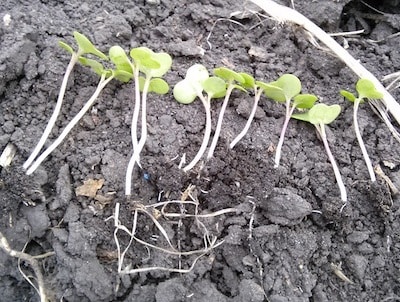
These seedlings were dug up to check how seeding depth varied by seeding speed. The plot seeded at 3 mph had 10 plants per foot of row and ranged from 1/2″ to 1-1/4″ deep.
The plot seeded at 5 mph had 13 plants per foot of row and ranged from 1″ to 2-1/4″ deep. Ten out of 13 of the plants were closer to the 2″ mark.
The seeding depth for both plots was intended to be 1/2″. We found significant variance with speed.
May 27 update
Halos of yellow were observed around the margins of some cotyledons in 5440 and L154 plots, but not in the SY4135.
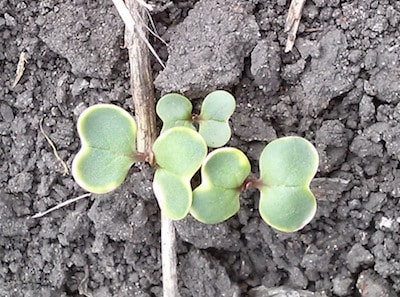
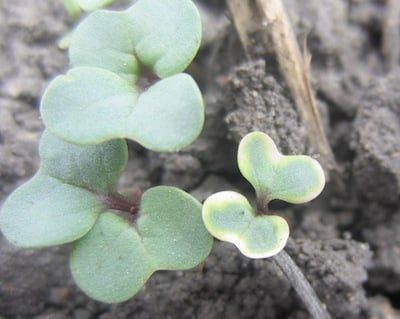
May 24 update
Emergence Counts were conducted on May 24.
Three plant counts were taken at the front middle and back of the strips, and there are three replicates for each variety — for a total of 9 counts each.
L154 = 8,14,6,10,12,11,18,24,12 = 12.78 plants/ft2
5440 = 5,5,4,18,20,13,11,24,4 = 11.56 plants/ft2
SY4135 = 12,11,15,9,9,16,10,12,16 = 12.22 plants/ft2
Average plants stands were close for each variety and each team, but the variability between counts is interesting. The team will do plant counts again next week.
Observations from the emergence counts:
5440 being broadcast looked to have some areas a little patchy and then others with almost too many plants. L154 was a bit better but had a few counts on the high and low end as potential outliers. SY 4135 counts were the most consistent. This may be a factor of the seeding speed differences between L154 at 5mph and SY 4135 at 3 mph.
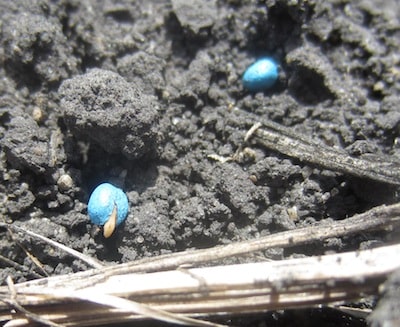
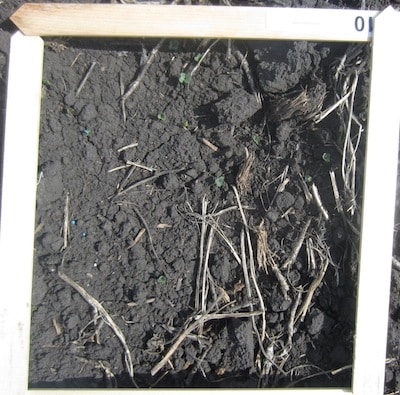
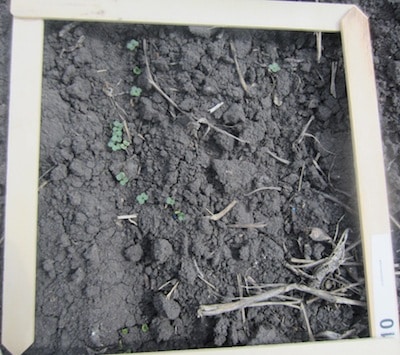
May 23 update
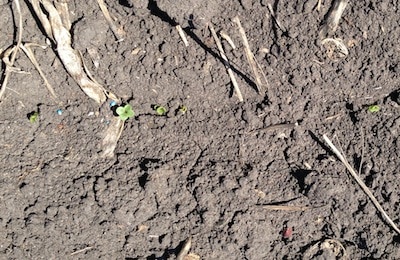
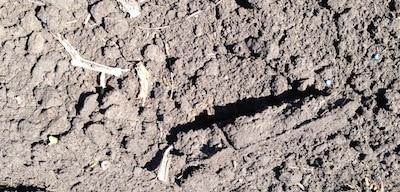
Most of the canola is at ground crack, and the odd cotyledon is showing 7 days after seeding.
The insect trap today had 11 bertha armyworm moths and 0 diamondback moths.
May 16 update
Kristen Phillips writes: I need to send out a huge thanks to Curtis Cavers and his crew at CMCDC – you all were a true pleasure to work with. Your knowledge of the farm and the equipment is outstanding and your ability to trouble shoot and get the job done is incredible! Today would not have been possible without the entire team. Thanks to Curtis, Danny, Neil, Bubba and the girls. Thank you for staying late and pushing hard to get the trial in before the rain! Now let’s see if the weather man is correct!!!
We had a very productive day today. First off, Danny Valmared on the fertilizer — 120-25-0-15. Then Neil disced it in on a 45° angle. The girls weighed out each of the seed lots so we had accurate TKW. Then we figured out our seeding rates based on each teams requests and calibrated the drills. The girls and Curtis staked the trial and we were ready to go.
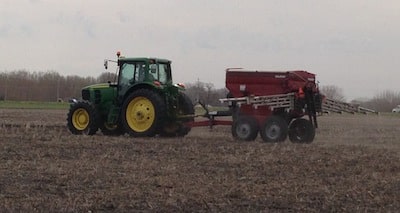
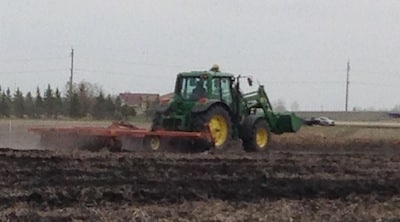
Team MAFRI’s variety was the first one to go in. SY4135 from Syngenta. (Justin Daymond from Syngenta donated the seed.) The TKW was 5.11 g. Team MAFRI targeted a 5.5 lb./ac. seeding rate so we used the following formula.
5.5 lb./ac. = ? X 5.1 g / (0.8) x 10
? = 8.6 plants per square foot.
We then calculated the number of seeds per foot of row so that we could calibrate the drill.
? = 8.6 x 6 / (0.8) x 12
? = 5.375 seeds per foot of row
We got the disc drill calibrated and we sowed MAFRI’s variety at 3 mph and 1/2 inch deep with no fertilizer with the seed.
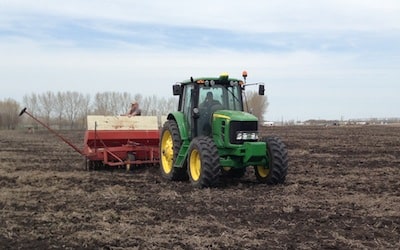
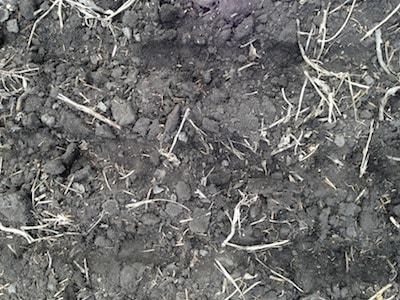
Team CROP variety was the second one to go in. L154 from Bayer CropSciences. (Harold Brown from Bayer CropScience donated the seed.) The TKW was 4.22 g. Team CROP was targeting a 5.0 lb./ac. seeding rate so we used the following formula.
5.0 = ? X 4.2 / (0.8) x 10
? = 9.48 plants per square foot.
We then calculated the number of seeds per foot of row so that we could calibrate the drill.
? = 9.8 x 6 / (0.8) x 12
? = 5.9 seeds per foot of row
We got the disc drill calibrated and we sowed CROP’s variety at 5 mph and 3/4-1 inch deep with 25 lb./ac. of P fertilizer (11-52-0) with the seed.
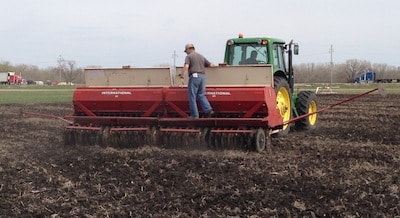
Team CCA. Because the rain was coming, Team CCA made a strategy change. They went from the decision of 7 lb./ac. with the hoe drill to 7.2 lb./ac. with the Valmar. TKW on this lot was 5.68 g. Team CCAs variety was 5440 from Bayer CropScience (Harold Brown from Bayer CropScience donated the seed.) No additional fertilizer went down with the seed in the Valmar. Team CCA’s canola then got harrowed in.
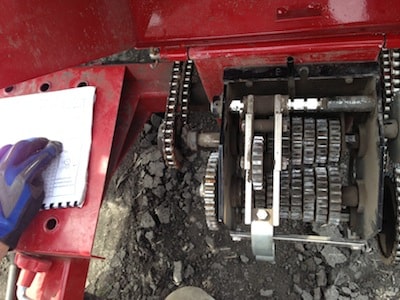
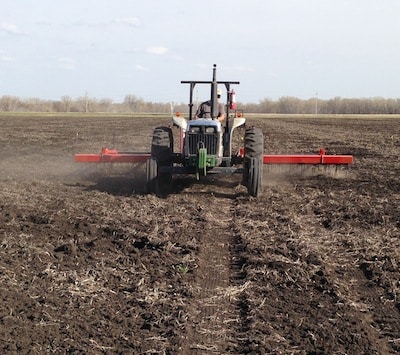
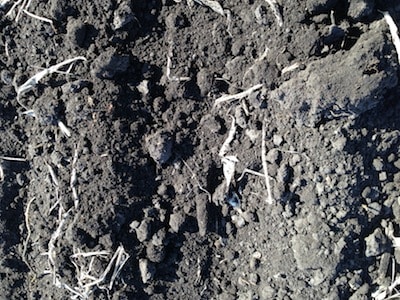
We finished the trial and then seeded down the guards so that we have some areas to showcase when we do the different scouting tours throughout the season. We should likely start planning the first blackleg scouting tour for that first week of June depending on when the crop emerges.
The Bertha and diamondback traps got set so that we can capture the insects each week!
We will set up the trail cams to do the time lapsed photography starting next week.
May 15 update
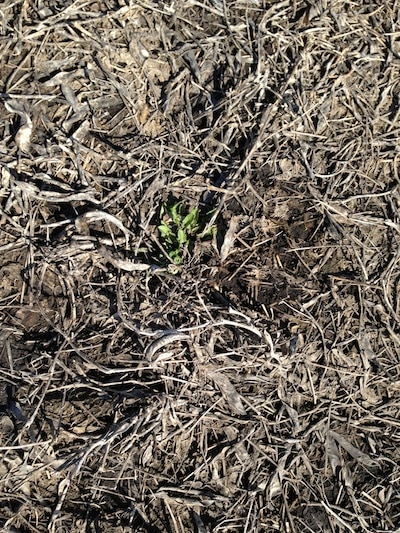
The 10-acre site was soil sampled May 8, and test results show 23 lb./ac. of nitrate-N in the top 6″, 57 lb./ac. of nitrate-N at 6-24″, 26 ppm of phosphate and 326 ppm of potassium. Soil pH is 8.0. UCC Manitoba soil test results. The previous crop was edible beans.
Seeding has not started (will probably occur this week), but each team has made its variety choice. Team CROP chose L154. Team CCA chose 5440. Team MAFRI chose SY4135. Teams must choose a variety from the 2013 Canola Production Trials.
Seeding equipment available to each team is shown in the photo above.. There are disk or hoe openers, and also a Valmar — not shown. We will provide more specifics once the teams have chosen their units. Costs for field work throughout the season will be based on the MAFRI Custom Rate Guide. CMCDC’s Field Crew will do the work so that that variable remains constant throughout the entire trial. Each team will have the ability to make timely management requests for the trials.
Several tours are planned at the UCC site throughout the year, including a blackleg scouting tour, a sclerotinia timing and scouting tour, CMCDC’s open house and grower group tour, the SCCC tour, and a disease scouting tour at swathing timing.
Weather reports
An ICMS weather station is one mile from the UCC site. Sample report from May 17:
